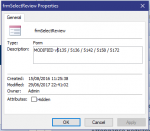Hello!
I would like to create a functionality in one of my forms that would allow me to list all my reports in a combobox/dropdown list and then allow me to directly open the report upon selecting the desired report name from the list. If possible, I would prefer the report to open in edit mode, in other words, not in presentation view but rather in regular view to allow me to do right click filtering, etc.
I have already created a table to list all my reports. THe table values are:
tblReports
ReportFormID (Autonumber)
ReportFormSelectionName (Text)
Thanks!
I would like to create a functionality in one of my forms that would allow me to list all my reports in a combobox/dropdown list and then allow me to directly open the report upon selecting the desired report name from the list. If possible, I would prefer the report to open in edit mode, in other words, not in presentation view but rather in regular view to allow me to do right click filtering, etc.
I have already created a table to list all my reports. THe table values are:
tblReports
ReportFormID (Autonumber)
ReportFormSelectionName (Text)
Thanks!


